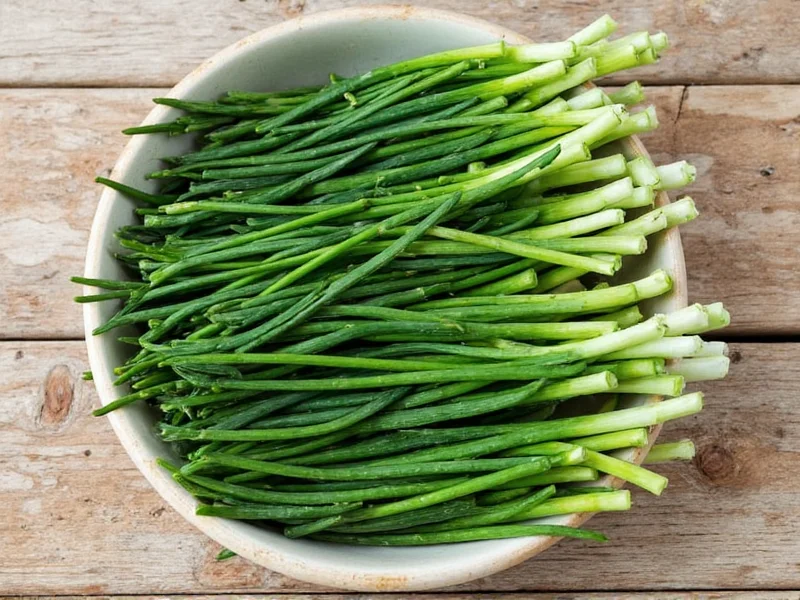Drying chives preserves their delicate onion flavor for year-round cooking. This versatile herb loses freshness quickly when stored fresh, but proper drying techniques maintain its culinary value while concentrating flavor. Whether you've harvested an abundant crop or bought more than you can use immediately, drying chives extends their shelf life significantly without sacrificing taste.
Preparing Chives for Drying
Before drying chives, proper preparation ensures optimal results. Start by harvesting or purchasing fresh, vibrant green chives without yellowing or wilting. Gently wash them in cool water to remove dirt and insects, then pat dry thoroughly with clean kitchen towels. Excess moisture prolongs drying time and increases mold risk.
Trim any damaged ends and separate the chives into uniform bunches if air drying, or chop them into consistent 1-2 inch pieces if using oven or dehydrator methods. Uniform sizing promotes even drying. For best flavor retention, avoid washing chives immediately before drying—allow them to air dry completely on a clean surface for 30 minutes after washing.
Drying Methods Compared
| Method | Time Required | Temperature | Flavor Retention | Best For |
|---|---|---|---|---|
| Dehydrator | 2-4 hours | 95°F (35°C) | Excellent | Preserving maximum flavor and color |
| Oven | 2-4 hours | 170°F (77°C) or lowest setting | Good | Quick drying when dehydrator unavailable |
| Air Drying | 1-2 weeks | Room temperature | Fair to good | Traditional method with minimal equipment |
Detailed Drying Techniques
Dehydrator Method (Best Results)
Arrange prepared chive pieces in a single layer on dehydrator trays, ensuring no pieces overlap. Set the temperature to 95°F (35°C) and dry for 2-4 hours. Check periodically after the first hour—properly dried chives will snap rather than bend. This method preserves the most flavor and color while preventing scorching.
Oven Drying Method
Preheat your oven to its absolute lowest setting, ideally below 200°F (93°C). Spread chives in a single layer on a parchment-lined baking sheet. Prop the oven door open slightly with a wooden spoon to allow moisture escape. Dry for 2-4 hours, checking every 30 minutes. Oven drying requires close monitoring to prevent burning, especially with convection ovens that circulate hot air.
Air Drying Method
For traditional air drying, tie chive bunches with twine and hang them upside down in a dark, warm, well-ventilated area with low humidity. A closet or pantry works well. Cover the bunches loosely with paper bags punctured with air holes to protect from dust while allowing airflow. Complete drying typically takes 1-2 weeks. This method preserves flavor reasonably well but takes significantly longer than mechanical methods.
Proper Storage of Dried Chives
Once completely dry and cooled, store chives properly to maximize shelf life. Transfer them to airtight glass containers or vacuum-sealed bags, removing as much air as possible. Store in a cool, dark place away from heat sources and direct sunlight. For extended preservation, consider adding oxygen absorbers to containers.
Label containers with the drying date—properly stored dried chives maintain optimal flavor for 6-12 months. While they remain safe beyond this period, flavor and color gradually diminish. Check periodically for moisture or mold, which indicates improper drying or storage conditions.
Using Dried Chives in Cooking
Dried chives work best in cooked dishes rather than as fresh garnishes. Rehydrate them by soaking in warm water for 10-15 minutes before use, or add directly to soups, stews, and sauces during cooking. Use about one-third the amount of dried chives compared to fresh, as drying concentrates their flavor.
Incorporate dried chives into compound butters, salad dressings, egg dishes, potato recipes, and breads. They pair particularly well with dairy-based sauces and dishes. For maximum flavor impact, add dried chives during the last 10-15 minutes of cooking to preserve volatile flavor compounds.
Troubleshooting Common Drying Issues
Mold development: Indicates insufficient drying or moisture during storage. Discard affected batches and ensure future batches are completely dry before storage.
Browning or scorching: Results from excessive heat during drying. Reduce temperature and increase drying time for future batches.
Loss of vibrant green color: Exposure to light or oxygen during storage. Store in opaque containers in dark locations.
Spongy texture after drying: Incomplete drying process. Return to dehydrator or oven for additional drying time.
Frequently Asked Questions
Can I dry chives in the microwave?
Yes, but with caution. Place chives between two paper towels and microwave on low power for 1-2 minutes, checking every 30 seconds. This method works quickly but risks burning and produces inconsistent results compared to other drying methods.
How do I know when chives are completely dry?
Properly dried chives will be brittle and snap easily when bent. They shouldn't feel leathery or flexible. When crushed between fingers, they should crumble rather than bend. Any moisture will cause them to stick together rather than separate into individual pieces.
Do dried chives lose their flavor?
Dried chives retain most of their flavor but become more concentrated. They lose some of the fresh, grassy notes but develop a deeper onion flavor. Proper drying and storage preserves up to 80% of the original flavor. For best results, use dried chives within 6-12 months of drying.
Can I freeze dried chives?
Yes, freezing dried chives in airtight containers extends their shelf life to 18-24 months. Ensure they're completely dry before freezing to prevent moisture condensation. Thaw at room temperature before use to avoid condensation on the herbs. Freezing preserves flavor better than room temperature storage.
What's the difference between dried chives and chive powder?
Dried chives are whole or chopped pieces that have been dehydrated, while chive powder is ground dried chives. Powder dissolves completely in liquids and distributes flavor more evenly, but loses flavor faster. Whole dried chives maintain texture and flavor longer but require rehydration or longer cooking time to release full flavor.











 浙公网安备
33010002000092号
浙公网安备
33010002000092号 浙B2-20120091-4
浙B2-20120091-4